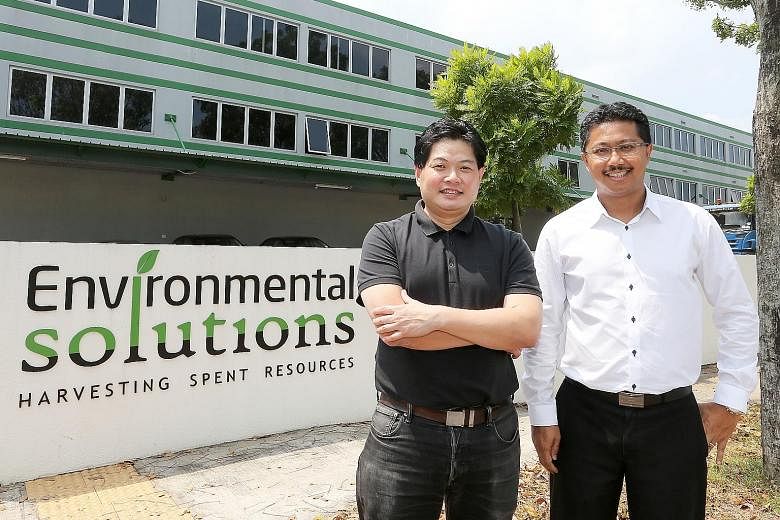Q Tell us about the journey of Environmental Solutions.
Mr Quek: While working for a waste-management firm back in the 1990s, we had a seed of an idea which germinated into Environmental Solutions a year later. The company initially operated from Siva's kitchen table with just our own computers and no Internet.
At the time, Singapore had many other waste-management companies but they could not handle "difficult" wastes like printed circuit boards and agrochemicals.
We knew we could. So we started providing transboundary solutions on waste management - the legal international transport of industrial waste - for multinational companies across South-east Asia.
We collaborated with firms in Europe which had the technological know-how, took care of logistics, got all required permits from the local authorities of different countries, and exported the materials on behalf of our clients. That was in 1999. We have come a long way since.
Q How did your company turn to recycling waste from managing it?
Mr Sivakumar: We had a fairly successful run as a transboundary company and developed a firm foundation in our field.
But we found out that much of the waste we transported contained precious and base metals, and were actually being purchased at a substantial price by the European firms.
So we decided to diversify from merely managing transboundary waste to processing the recyclable industrial waste streams ourselves.
Soon we were storing and recycling waste. We moved out of our home office into a bigger space in Chinatown. Later, we rented a few other places before buying our own factory space in Tuas and here we are today.
Mr Quek: The business now has two fronts. In procuring waste materials, we are a waste-management company, but when it comes to selling base and precious metals, we are a commodity trader. We also provide hedging services for our precious-metal clients. Hedging is an essential and necessary aspect of any successful physical commodity-trading business.
Q How does Environmental Solutions help reduce the carbon footprint?
Mr Sivakumar: Our business is analogous to mining. Where mining begins with ore, we begin with industrial waste containing base and precious metals. We buy much of the waste materials - things like catalytic converters in automobiles, spent industrial catalysts and other metal-bearing sludges.
We upgrade this waste through a combination of mechanical and thermal processes, concentrating the targeted metals within - like copper, lead and, sometimes, gold and silver. The process is similar to concentrating sugar solution into a syrup by heating.
This upgrades the unit value of the original waste materials, and this upgraded material is then sold into the commodity market, through which we generate revenue.
Mr Quek: We also harvest heat energy from discarded wood, such as pallets, crates and boxes. Waste wood - which would otherwise go to landfills - is the main source of energy for our kilns and ovens. This is our way of expressing our belief in sustainability.
Harvesting spent resources in this manner is the real sustainable alternative to mining. Our vision for our business is a world of infinite resource life cycles. We are already recovering pure previous metals, and we have set in motion plans to commence full recovery of some targeted base metals.
Q What are the challenges you face?
Mr Sivakumar: Singapore is a relatively small marketplace for our business. If we want to make a significant impact on the region, we need to import valuable waste materials - which we see as resources - into our Tuas plant for recovery. Current regulations do not allow us to do so.
Mr Quek: Having been in the field for so long, we know that thousands of tonnes of materials travel from Asia to Europe for recovery. Even Australia sends materials to Europe, so why not stop in Singapore instead? Only some high-value materials such as automobile catalysts are not regulated, so we import them. We are one of the biggest players in Asia for this material.
Q Tell us about your new endeavour, ES Power.
Mr Sivakumar: ES Power is our power/energy division, which commenced operations last year. It is a unique brand of carbon-neutral electric power.
Through ES Power, we offer our customers zero carbon footprint from electricity consumption. We are the first electricity retailers to offer this proposition.
Mr Quek: Our power company will purchase carbon credits from the international carbon market in bulk and allocate them to customers in Singapore that buy power from us, thus reducing their carbon consumption to zero.
The man in the street might not know what carbon-neutral electricity means now, but he will know soon enough when a carbon tax is introduced in Singapore in the coming years. Carbon is the global currency for sustainability in future, and we are offering our customers a chance to be part of the carbon economy, which will soon be a reality.
Q How does this zero carbon power work?
Mr Sivakumar: Most people want to go green but don't know how to do it. At the most, they will throw their recyclables into a certain bin.
In Singapore, there is something called the Grid Emission Factor that is used to estimate the amount of carbon dioxide emitted by a power plant vis-a-vis a unit of electric power generated.
Here, this amount is 0.43 tonne of carbon dioxide a megawatt hour of electricity produced.
Mr Quek: Let us say I am a factory which is emitting X amount of carbon dioxide. After modifications in operational and business processes to reduce the carbon footprint, I will reduce my footprint to a Y amount. The difference (X minus Y) can be sold in the international carbon market (in the form of credits). Mr Sivakumar: The monetisation of these credits is an incentive for firms to maintain emission-reduction programmes.
More people will then get on board and this will eventually help the global environment by reducing greenhouse gas emissions.
Q How does ES Power contribute to your motto of social responsibility?
Mr Quek: Our social mission is to offer electricity at reduced special prices to social enterprises such as special needs schools or social welfare groups.
These are listed on our corporate website; what we call our "micro philanthropy" platform. This platform allows the public to make contributions, something akin to crowdfunding. Only this time, the funds will be used to offset part of the bills of these social organisations.


